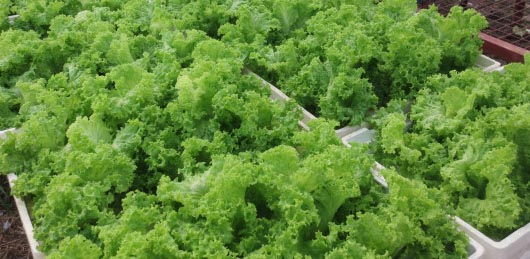You only need styrofoam boxes and cups, vegetable seeds, coco coir or saw dust, water and a liquid complete fertilizer and voila!—you can have your own vegetable garden in your own houses. This is the idea behind SNAP—an acronym for Simple Nutrient Addition Program, the latest hydroponics system developed at the University of the Philippines at Los Banos (UPLB) Institute of Plant Breeding (IPB). SNAP also connotes the literal meaning of the word—easy job, breeze, smooth-sailing, cinch, quick.
In 1999, scientists Primitivo Jose Santos and Eureka Teresa Ocampo, both university researchers, started to develop a low-cost hydroponics system. “That was our objective,” Dr. Santos explained. “If we use the imported hydroponics system, farmers really cannot afford it. A small greenhouse can cost around P4 million. So we tried to explore other possibilities and leading to the development of SNAP hydroponics.”
Using coco-coir or saw dust acting as the growing medium that will hold the root system of the plant, Dr. Santos said the SNAP hydroponics technology is very successful growing leafy vegetables like lettuce, pechay, mustard and even upland kangkong. “Those are the crops that I advice beginners to plant because they’re very easy to grow. But for those who have experience in soil less gardening, you can also plant tomato, watermelon, cucumber and eggplant.”
The main difference between SNAP hydroponics and other forms of hydroponics systems, according to Dr. Santos, is their nutrient solution, which they developed in their laboratory. “This is what we call the complete fertilizer supplementation. Normally, the fertilizers that you can find in the market are just the basic nitrogen, phosphorus and potassium (NPK), which we consider a misnomer. The nutrient solution that we have developed contains all the essential nutrients that the plants needed. This solution is now available in liquid form.”
According to Dr. Santos, the SNAP hydroponics nutrient solution is very cheap. “Based on our economic studies, a farmer can easily get around more than 50% of their Return-On-In-vestment (ROI) if they use this technology. In fact, a farm in San Jose, Batangas has adapted this and also came up with that figure.”
Dr. Santos declared that in adapting SNAP hydroponics, one has the option to spray insecticides or fungicides in the plant. “You can actually combine organic and inorganic cultural methods. You can use botanical insecticide or you can merely pick up and kill the insects yourself. It’s really your choice. The only thing I advice is that if you grow your vegetables near the window, make sure there’s morning sunlight there,” said Dr. Santos
Assembling SNAP Hydroponics System
Materials needed:
- Seedling plugs (used cups)
- SNAP nutrient solution
- Growing boxes (used Styrofoam boxes)
- (Optional) Benches or stand-where the growing boxes will be placed under a shelter.
- Rain shelter (or roof awning facing east for the earliest and longest sunlight possible)
- Plastic drum or orocan drum – where the SNAP nutrient solution will be mixed (for commercial production only)
Procedure:
- Arrange the growing boxes on the bench under the shelter. Take off the cover/lid.
- Fill each growing box with around 10 liters of tap water.
- Add of SNAP A and SNAP B solutions to each box of water then stir well.
- Put back the cover of the box.
- Place the seedling plugs on the holes of the cover. See to it that all cups are “inserted” uniformly or level from one another.
- See to it that the bottom of the box is touching the nutrient solution. If not, add more water until the desired level is reached.
- Examine the boxes for leaks and make some troubleshooting.
- Visit the set up every morning as early as you can to catch any insect larva that may eat the plants (the larva is visible in the early morning. After that, they tend to hide already and harder to find)
- Expect the nutrient solution level to go down when the plants are much bigger than were they were still small seedlings. Replenish the solution when more than one inch from the cup bottom has been depleted.
- NEVER allow the level of the solution to reach the bottom of the cup; Replenish until about 1/2 inch below the cup’s bottom.
For you to understand better see this video:

